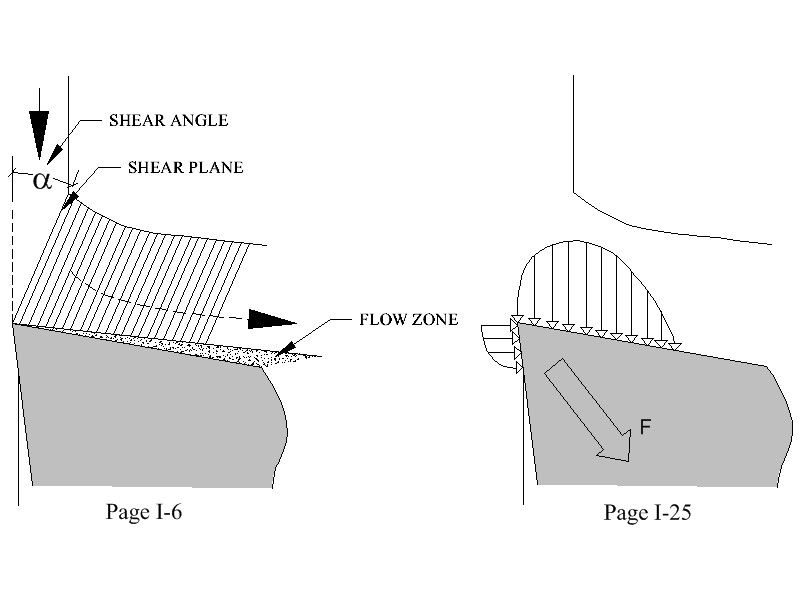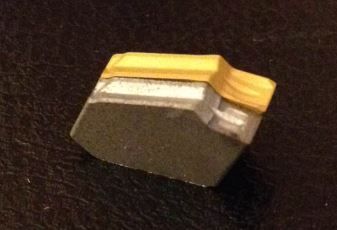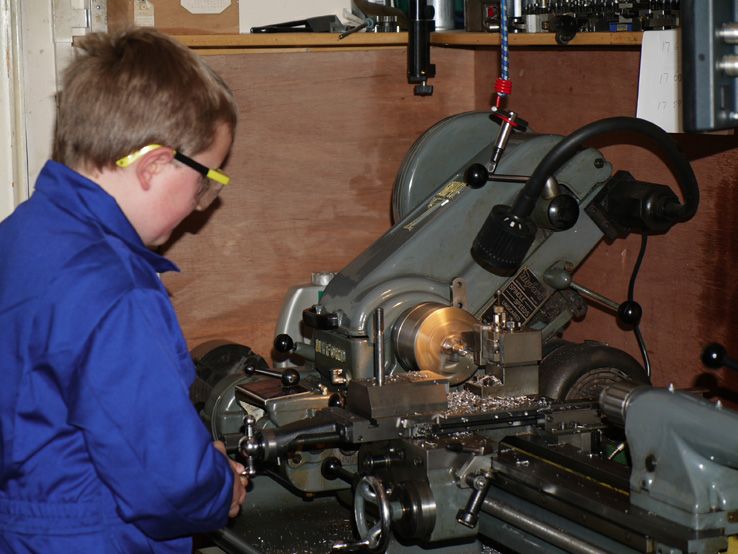Having gratefully taken repossession of The Good Book Sandvik, done some revision, and had a think about how to put this one together …. these sketches of what happens at the cutting region are based on two in the Sandvik book:

I-6: The chip is sheared off the parent metal as the work passes the tool, and flows across the rake face. The angle of the shear plane depends on the material, rake angle, feed, depth of cut and speed. Between the deformed chip and the rake face is the flow zone, where the speed of the material varies from near zero at the rake face to chip speed – material in the flow zone is therefore subject to shear, so there’s some force being exerted by the chip as it moves along above the flow zone, which in turn gets passed onto the tool.
I-25: Indicates the distribution of compressive stress in the work piece, which combine to produce the F, the force on the tool. Obviously, the magnitude and direction of F again depend on material, rake angle, feed, depth of cut and speed.
Once those parameters are set (e.g. parting steel, 2mm wide tip, 0.002”/rev feed, 6 degree rake angle, 1000 rpm), the magnitude and direction of the force on the tool is fixed, and will not change during cutting. So if the tool starts off cutting ok, it will continue in that vein, and will not have any tendency to dig-in part way through the cut. Full stop!
The major influence on the force and its direction are the side and top rake angles on the tool, for parting we’re only interested in the top rake. Increasing the rake angle reduces the force significantly, Sandvik quote a reduction of 1% – 1.5% for every degree more positive. Increasing the top rake also reduces the radial component, and although I can’t find any figures of % reduction/degree, it is obvious that it could eventually disappear altogether – this would be the point at which a tool would develop a tendency to dig in. But that is not going to happen during parting/turning operations, because the tool’s rake angle is fixed.
The example of drill grabbing when breaking through or opening out a hole is a different situation, and does not provide a valid comparison with what would happen during parting. It is, however, an excellent example of the influence of rake angle!
The rake angle of a conventional twist drill varies from centre to lip, from zero or near-zero degrees at the web, to helix angle at the lip, so say from 0 to 30 degrees. Furthermore, the point of a drill does not shear away the metal in its path, as a turning or parting tool does, but forces it out of the way by plastic flow. Which is why, if you stop the drill at the right moment, you get a raised pip on the underside of the work.
So you continue to break through, when one of two things can happen:
1) The flutes of the drill engage with the bits of uncut but deformed metal around the periphery, and the helix drags the drill in, or:
2) The gradually increasing rake angle reduces the tangential and radial forces to a level at which the drill can dig in.
Or a combination of the above.
As far as opening up a pre-drilled hole is concerned, obviously 1) above does not apply at the start of the hole, so grabbing is then down to 2) on its own. Of course, it’s not just brass that does this, steel can do it as well, as anyone who has tried to open up a hole in steel with an electric hand drill can attest. But it certainly is more prevalent with brass.
As a further example of rake effects, we need only look at how to avoid drills grabbing in brass – stone a flat on the lip, so zero rake all the way across the drill radius, or use a slow helix drill, with typically 13 degrees helix angle, so that the rake doesn’t go ‘over the top’ at the lips.
As far as Chris’s adventure with an aluminium tip is concerned, again it’s down to inappropriate rake angles. An aluminium tip has a top rake of 20 – 25 degrees, so cutting force down by something between 20% and 37% and radial force very much reduced, perhaps gone altogether. Additionally, there will have been some side rake that further reduces the radial component, and possibly an additional effect of the entering angle, if it wasn’t 90 degrees.
So I hope the foregoing has now convinced you that:
1) The reasons for drills grabbing in brass are readily explained, and relate basically to the rake angle at the lip of standard helix drills.
2) Comparing what happens when drills grab in brass with parting operations is not valid.
3) A correctly formed (i.e. with sensible and realistic top rake) and set up parting tool does not have any tendency to ‘dig in’.
Mark C.








